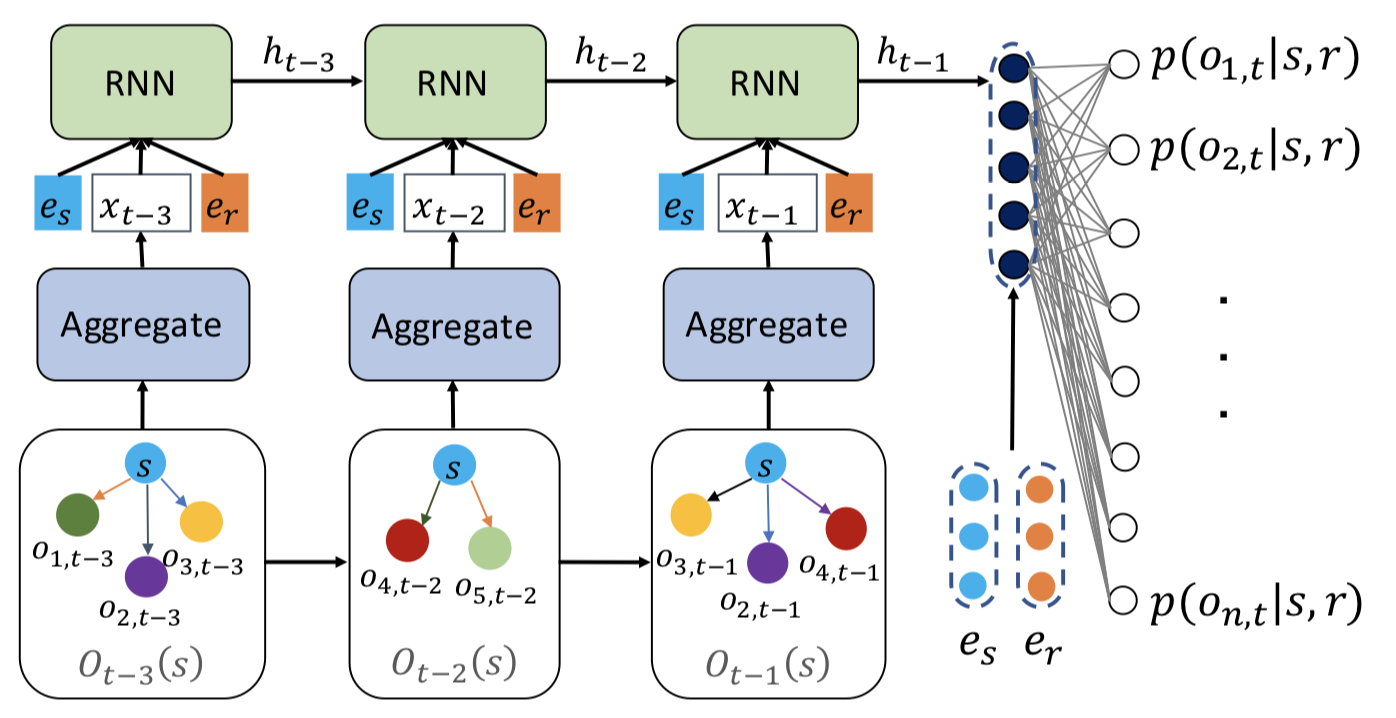Paper: Recurrent Event Network for Reasoning over Temporal Knowledge Graph
This repository contains the implementation of the RE-Net architectures described in the paper.
Recently, there has been a surge of interest in learning representation of graph-structured data that are dynamically evolving. However, current dynamic graph learning methods lack a principled way in modeling temporal, multi-relational, and concurrent interactions between nodes—a limitation that is especially problematic for the task of temporal knowledge graph reasoning, where the goal is to predict unseen entity relationships (i.e., events) over time. Here we present Recurrent Event Network (RE-Net)—a novel neural architecture for modeling complex event sequences—which consists of a recurrent event encoder and a neighborhood aggregator.
If you make use of this code or the RE-Net algorithm in your work, please cite the following paper:
@article{jin2019recurrent,
title={Recurrent Event Network for Reasoning over Temporal Knowledge Graphs},
author={Jin, Woojeong and Jiang, He and Zhang, Changlin and Szekely, Pedro and Ren, Xiang},
journal={arXiv preprint arXiv:1904.05530},
year={2019}
}Install PyTorch (>= 0.4.0) and DGL following the instuctions on the PyTorch and DGL. Our code is written in Python3.
Before running, you should preprocess datasets.
For attentive, mean, pooling aggregators (model 0,1,2)
cd data/DATA_NAME
python3 get_history.pyFor an RGCN aggregator (model 3)
cd data/DATA_NAME
python3 get_history_graph.pyThen, we are ready to train and test. We first train the model.
python3 train.py -d DATA_NAME --gpu 0 --model 0 --dropout 0.5 --n-hidden 200 --lr 1e-3 --max-epochs 20 --batch-size 1024We are ready to test!
python3 test.py -d DATA_NAME --gpu 0 --model 0 --n-hidden 200The default hyperparameters give the best performances.
The user must specify a --model, the variants of which are described in detail in the paper:
- Attentive aggregator: --model 0
- Mean aggregator: --model 1
- Pooling aggregator: --model 2
- RGCN aggregator: --model 3
There are related literatures: Temporal Knowledge Graph Embedding, Dynamic Graph Embedding, Knowledge Graph Embedding, Static Graph Embedding, etc. We organized the list of related work.
There are four datasets: ICEWS18, GDELT, WIKI, and YAGO. Each data folder has 'stat.txt', 'train.txt', 'valid.txt', 'test.txt', 'get_history.py', and 'get_history_graph.py'.
- 'get_history.py': This is for getting history for model 0, 1, and 2.
- 'get_history_graph.py': This is for getting history and graph for model 3.
- 'stat.txt': First value is the number of entities, and second value is the number of relations.
- 'train.txt', 'valid.txt', 'test.txt': First column is subject entities, second column is relations, and third column is object entities. The fourth column is time. The fifth column is for know-evolve's data format. It is ignored in RE-Net.
We use the following public codes for baselines and hyperparameters. We validated embedding sizes among presented values.
| Baselines | Code | Embedding size | Batch size |
|---|---|---|---|
| TransE (Bordes et al., 2013) | Link | 100, 200 | 1024 |
| DistMult (Yang et al., 2015) | Link | 100, 200 | 1024 |
| ComplEx (Trouillon et al., 2016) | Link | 50, 100, 200 | 100 |
| RGCN (Schlichtkrull et al., 2018) | Link | 200 | Default |
| ConvE (Dettmers et al., 2018) | Link | 200 | 128 |
| Know-Evolve (Trivedi et al., 2017) | Link | Default | Default |
| HyTE (Dasgupta et al., 2018) | Link | 128 | Default |
We implemented TA-TransE, TA-DistMult, and TTransE. The user can run the baselines by the following command.
cd ./baselines
CUDA_VISIBLE_DEVICES=0 python3 TA-TransE.py -f 1 -d ICEWS18 -L 1 -bs 1024 -n 1000The user can find implementations in the 'baselines' folder.
In the ICEWS18 dataset, the results with filtered metrics:
| Method | MRR | Hits@1 | Hits@3 | Hits@10 |
|---|---|---|---|---|
| TransE | 17.56 | 2.48 | 26.95 | 43.87 |
| ConvE | 37.67 | 29.91 | 40.80 | 51.69 |
| TA-DistMult | 28.53 | 20.30 | 31.57 | 44.96 |
| RE-Net (mean) | 42.38 | 35.80 | 44.99 | 54.90 |
| RE-Net (attn) | 41.46 | 34.67 | 44.19 | 54.44 |
| RE-Net (pool) | 41.35 | 34.53 | 44.05 | 54.35 |
| RE-Net (RGCN) | 43.20 | 36.63 | 45.58 | 55.91 |
In the GDELT dataset, the results with filtered metrics:
| Method | MRR | Hits@1 | Hits@3 | Hits@10 |
|---|---|---|---|---|
| TransE | 16.05 | 0.00 | 26.10 | 42.29 |
| ConvE | 36.99 | 28.05 | 40.32 | 50.44 |
| TA-DistMult | 29.35 | 22.11 | 31.56 | 41.39 |
| RE-Net (mean) | 39.15 | 30.84 | 43.07 | 53.48 |
| RE-Net (attn) | 38.07 | 29.44 | 42.26 | 52.93 |
| RE-Net (pool) | 37.99 | 30.05 | 41.40 | 52.18 |
| RE-Net (RGCN) | 40.21 | 32.54 | 43.53 | 53.83 |
In the WIKI dataset, the results with filtered metrics:
| Method | MRR | Hits@1 | Hits@3 | Hits@10 |
|---|---|---|---|---|
| TransE | 19.30 | 14.01 | 24.01 | 25.82 |
| ConvE | 49.57 | 48.23 | 51.07 | 52.53 |
| TA-DistMult | 48.09 | 46.01 | 49.51 | 51.70 |
| RE-Net (mean) | 48.30 | 45.86 | 49.36 | 53.03 |
| RE-Net (attn) | 51.72 | 50.60 | 52.12 | 53.72 |
| RE-Net (pool) | 45.15 | 41.41 | 46.98 | 52.57 |
| RE-Net (RGCN) | 50.47 | 49.80 | 52.03 | 53.16 |
In the YAGO dataset, the results with filtered metrics:
| Method | MRR | Hits@1 | Hits@3 | Hits@10 |
|---|---|---|---|---|
| TransE | 34.78 | 20.27 | 47.23 | 53.35 |
| ConvE | 64.32 | 63.79 | 65.97 | 67.60 |
| TA-DistMult | 62.72 | 59.30 | 64.94 | 68.19 |
| RE-Net (mean) | 65.51 | 63.85 | 66.06 | 68.03 |
| RE-Net (attn) | 65.79 | 64.50 | 66.00 | 67.82 |
| RE-Net (pool) | 63.65 | 61.25 | 64.76 | 67.45 |
| RE-Net (RGCN) | 65.69 | 64.83 | 66.32 | 68.48 |
